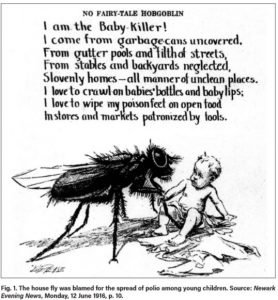Insects play an important role in environment. Without insects, life is impossible on earth. Besides their marvelous services, they have negative impacts on humans life because insects act as a vector for disease transmission.
 A vector is living organism which transmit the infectious diseases or pathogens from one organism to another organism. Vectors can transmit diseases directly by biting to host indirectly by contaminating food.
A vector is living organism which transmit the infectious diseases or pathogens from one organism to another organism. Vectors can transmit diseases directly by biting to host indirectly by contaminating food.
According to WHO, more than 17% of contagious diseases are vector-borne such as chikungunya yellow fever human African trypanosomiasis, dengue, zika virus, malaria etc.
Housefly
House fly, Musca domestica L. (Diptera: Muscidae) is a common insect species which can be found everywhere due to its widest distribution in the world. It is included in the category of “filth flies”. It mostly lives near human habitats Houseflies act as major “pest” not only for humans but also for livestock and poultry facilities.
It is not considered as neatest insect. It is known as mechanical vector for many disease-causing pathogens. Houseflies usually feed on human feces, decaying matter (e.g. vegetables, meat fruits etc.) which contains diverse pathogens. These disease-causing microorganisms stick with the body of house flies and contaminate human foods.
Role in disease transmission
Before the Spanish-American war in 1898, It was thought that M. domestica was a harmless insect for human life. But this thought was changed after epidemic of typhoid fever during this war which caused the death of five thousand soldiers. The reason of typhoid fever outbreak was house fly and acted as vector for Salmonella typhi (typhoid bacillus).
House fly is carrier of over 100 different pathogens including virus. Bacteria, fungi, metazoans and protozoans. According to an estimate of World Health Organization (WHO), there are 65 diseases which are transmitted in humans by house flies. For example: anthrax, cholera, typhoid fever, tuberculosis and dysentery.

There is a link between the seasonal increase in diarrheal patients and house fly’s population. Researchers found that house fly contains a pathogen called Helicobacter pylori that can cause stomach cancer in humans.
Another example is Soil transmitted helminths (STH) which is infecting 1.5 billion people in world. Indirect transmission this intestinal parasite involves houseflies.
The human pathogens that house flies can carry involves Pseudomonas spp, Shigella spp. Staphylococcus hominis, Klebsiella spp., Campylobacter spp., S. aureus, Enterococcus faecalis, Acinetobacter spp., Trichuris trichiura, Strongyloides larvae, Entrobious vermicularis,
House fly usually adopt three different ways to transmit pathogens;
- By sticking pathogens with their body parts
- By depositing pathogens in their feces
- By vomiting saliva on their food during sucking of food
Cockroaches
There are more than 4000 species of cockroaches throughout the world, most of them are living in tropical areas. They love to live in wet and dark areas. Cockroaches lives in houses but they also survive in tree bark and leaf litter in temperate regions and grasslands, rotting logs, ant caves, bird nests and sand dunes in tropical regions. They mostly live in groups and active at night. The main source of feeding is human feces. They also contaminate food.
According to the present structure of classification, cockroaches are placed in Dictyoptera and suborder Blatarria. Cockroaches exists in five major families: Blattidae, Polyphagidae, Crytocercidae, Blattellidae and Blaberidae.
Some of the scientific names of the different species of cockroaches are the Asian cockroach (Blattella asahinai), American cockroach (Periplaneta americana), the Oriental cockroach (Blatta orientalis), the Florida woods cockroach (Eurycotis floridana), and the German cockroach (Blattella germanica).
Role in disease transmittance
Undoubtedly, cockroaches can also make you sick!
Cockroaches produce secretions from their glands to produce foul odor. They act as carrier of human diseases especially intestinal diseases. Sometimes, repeated exposure can cause allergic reactions in people. Besides this, they also cause serious respiratory problems and dispersal of Staphylococcus aureus, Streptococcus and E. coli.
Even with persistent cleanliness, the retention period of cockroach dust or allergens is six months. The mechanisms for transmission of diseases is same as for houseflies. They can also contaminate human food and thus transmitting diseases indirectly. German cockroach is known for carrying E. coli.
The pathogens carried by a cockroach can cause following diseases;
- Giardia
- Plague
- Leprosy
- Dysentery
- Allergic reactions
- Typhoid fever
- Cholera
- Salmonellosis
Conclusion
Presence of houseflies and cockroaches is a sign of unhygienic conditions. They are most notorious pests. Their life cycle, habitat and feeding materials make them ideal mechanical vectors.
Many studies proved that both insects are reservoirs of contagious pathogens. Consequently, their role as a vector for transmittance of diseases cannot be neglected. There is a need to control the population of these vectors to minimize the outbreak of infectious diseases in humans.